Cat Behaviour & Care
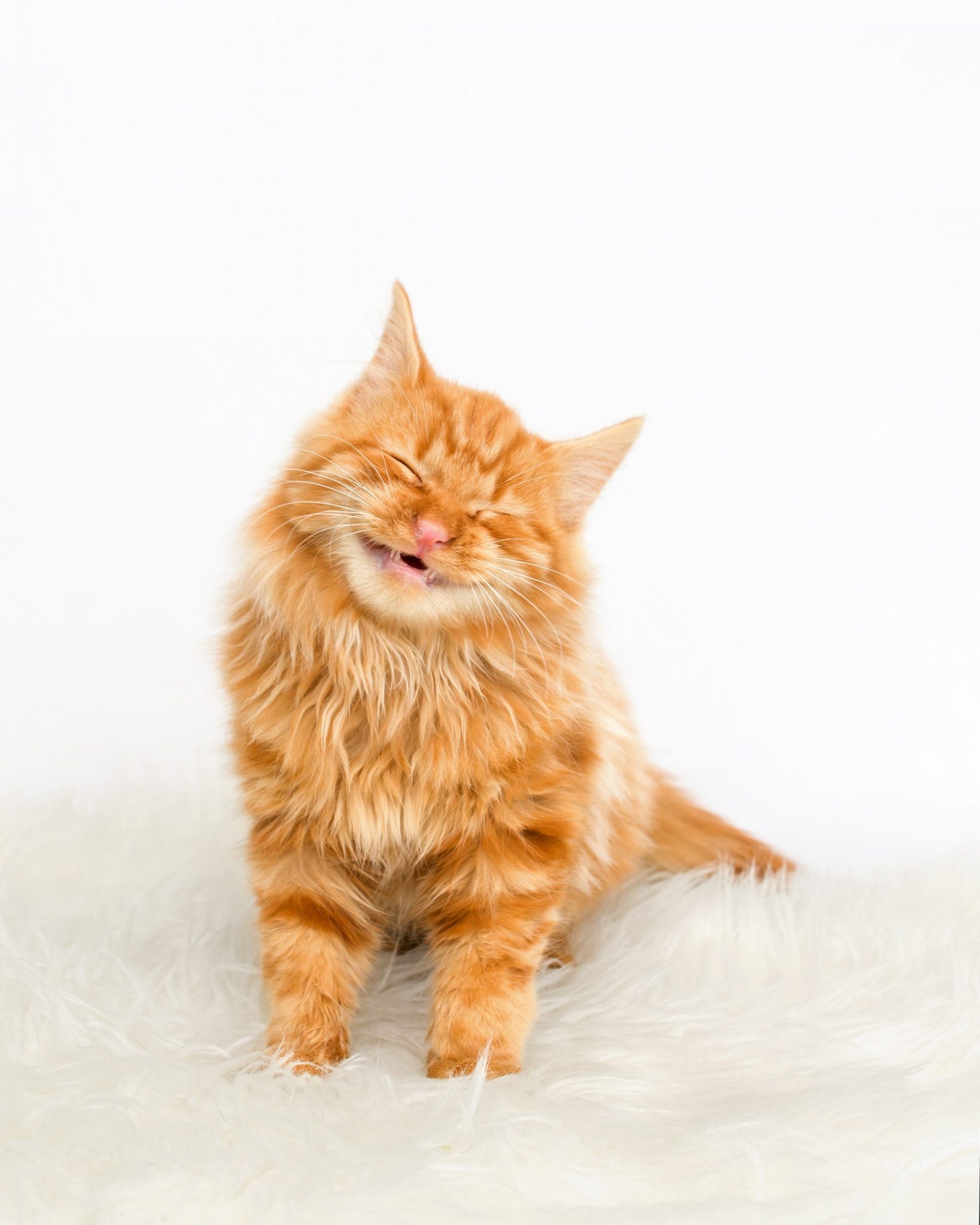
Cats make wonderful companions. Although they are more emotionally independent than dogs, cats still require your time, affection and commitment. If you have adopted a cat or kitten from one of AWLQ’s rehoming centres, thank you for choosing to adopt and saving a life. Bringing a new cat or kitten home might not as simple as it sounds – cats are highly intelligent and complex little creatures, which is why we have pulled all of our expert knowledge together to make the transition from shelter to home that much easier. Below you will find a wide range of resources to help your new cat settle in. If you have a question that isn’t covered in this guide, get in contact with us by emailing info@awlqld.com.au or calling the Rehoming Centre you adopted your cat from.
Our animal attendants pride themselves on the level of care we invest in our animals, the chances are that we know a few things to help your cat settle in.
Have you recently adopted a cat?
Introducing your new cat to your existing care
The information in this booklet is intended as a general guide only
Introducing a new cat into a household with an existing cat isn’t always easy. Even when we humans have our existing cat’s happiness at heart (ie we’ve adopted the new cat as a ‘friend’ for the old one), first introductions don’t always go as smoothly as we would like! In reality, your existing cat will most probably be a bit stroppy about the new arrival and it will take some time to adjust. When bringing a new cat into your home there are few things you can do, however, to make the adjustment easier for your old cat as well as your new one.
Give them space
Before you even bring your new cat home, prepare him a room of his own with his own bedding, food bowls and litter tray. A bedroom, laundry or bathroom is suitable, but it must have a closable door. It is very important to make sure you do not change your existing cat’s feeding and sleeping arrangements once the new cat arrives, so giving the new cat his own room for a few days will minimise any upset to your old cat’s routine.
When the time to comes to bring your new cat into the home, bring him straight to his ‘room’, open the cat carrier door and allow him to explore his new surroundings. He may hide at first or seem nervous – this is perfectly normal. Do not force him to come out of his hiding spot or to interact and play if he does not want to. Just shut the door and give him some space and quiet time in the room alone to get used to his new home.
Investigating new smells
After a few hours, take a blanket or toy with your new cat’s smell on it and place it in the main living area of your existing cat. Do the same again but taking something with your existing cat’s smell and placing it in your new cat’s room. Allow the two cat’s time to investigate these new smells. Also allow them to sniff each other through the closed door – some hissing may occur, but with the door between them nothing can come of it, so don’t worry!
Time to explore
After a few days, confine your existing cat to the new cat’s room and let your new cat out to explore the rest of the house. Allow each of them time to explore the other’s living areas and get used to one another’s smells. After some time return them to their previous living arrangements and wait another day before allowing them to meet face-to-face.

When your cats meet for the first time expect some stand-offs
At last we meet!
When you think it’s time to let the two meet face-to-face, put your new cat in a cat carrier and bring him out into your existing cat’s living space. Allow them to sniff at each other through the carrier door at first. There will be some hissing – this is to be expected. Watch carefully and when your old cat seems to have calmed down, open up the carrier door and allow them to roam freely in the same space, under your watchful eye. There will be some stand-offs and it may take quite some time for them to become ‘friends’ (if ever).
Keep your new cat’s room set up as it has been for a few more days to allow him a place to escape if he is getting bullied by your old cat. There is no need to continue to lock him away unless you feel that you cannot trust the two cats together without your supervision. In this case, try not to leave them alone in the same room together until you feel comfortable that they will not fight. When you do feel at ease, you can then move your new cat’s food bowls and litter tray out of his room and into the main living area with your other cat.
Remember to give your existing cat some extra time, attention and treats to avoid excessive jealousy.
Each to their own
Cats living in multi-cat households MUST each have their own space in which to escape and spend time apart from one another if they so wish. Each cat should also be provided with his own litter tray and food bowls, separate from the other cats’.
It takes time
Whatever you do, DO NOT force the two cats to come together and ‘make friends’. Allow them the time to make up their own minds about each other and accept that some cats will eventually become friends, but some may not. You will need to allow at LEAST TWO WEEKS to judge whether or not they are going to get along, and even if it looks as though the two will not be best friends, this does not mean that they cannot live happily in the same house. Cats are not humans and they are not dogs. They are amazingly good at tolerating others in their environment that they don’t particularly like (just look at all the cats at the Animal Welfare League that are placed in the rehoming pens every day that don’t know each other – they learn to tolerate each other in a surprisingly short period of time!)
As long as you provide each of your cats with their own space (as described above) and don’t place unrealistic ‘human’ expectations on them (i.e. that they have to be best friends otherwise it’s not going to work), they will adapt to their new situation eventually and settle down.

Give them time and your cats may become the best of friends
Basic grooming
BASIC GROOMING
The information in this booklet is intended as a general guide only
All cats need to look their best; not just for aesthetic purposes, but also to maintain optimum health and happiness. Every cat owner needs to know some basic grooming skills. Even short-haired cats need basic grooming and all cats benefit from the one-on-one contact and bonding that a grooming routine develops between them and their owners.
Brushing
Cats spend much of their time grooming themselves by licking their fur with their rough tongues. This dislodges any loose hairs from the cat’s coat, but it also causes hairballs to form in their stomachs. Regular brushing of your cat’s coat will get rid of any dead hair and lessen the amount of hairballs that form.
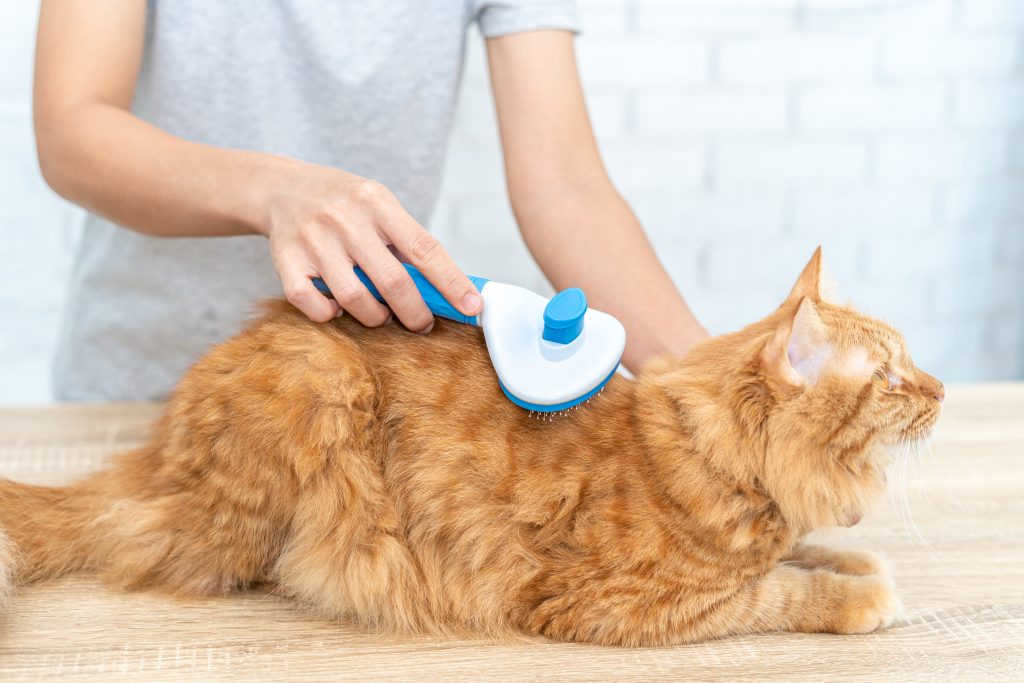
Short-haired and medium-haired cats will need to be groomed about once a week
Brushing sessions can provide a perfect bonding opportunity for you and your companion cat. Many cats will be happy to sit on your lap or next to you whilst you groom them. Otherwise, you can use a table with a non-slip surface.
Short-haired Cats
When brushing cats with short hair, you can simply use a fine-toothed steel comb to remove the dead hair.
You can also use a rubber glove or soft cloth and lightly stroke over the coat to bring out the shine.
Long-haired Cats
You will also need a steel comb to start off with when grooming a long-haired cat. You will need a comb that has fine teeth on one side and wider teeth on the other.
Check first to see if the cat has any tangles in its fur. Start with running the wide-toothed comb gently through the coat from head to tail, then along the stomach and front and back legs. After this, repeat the whole process using the fine-toothed comb.
A small, fine comb is good for brushing areas such as the face and ears, but these are very sensitive and will require gentle handling. It helps if the cat knows and trusts you and grooming is a regular routine.
The most important thing when grooming long-haired cats is to avoid mats forming in the coat. Avoid this by making sure that when you brush the hair you brush through the entire length of the coat, not just the top layer.
If you do notice some matting in the fur, gently separate the matted hair using your fingers first. Then gently comb the knot out. If the matting is too clumped together you may need to cut the knots out or even seek professional help from a vet or groomer if the coat is very bad.
Failure to regularly brush a long-haired cat can result in severe matting which is painful for the cat as it pulls on the skin. Severe matting may even require the cat to be anesthetised in order to shave the mat (such as with the Persian in the picture above).
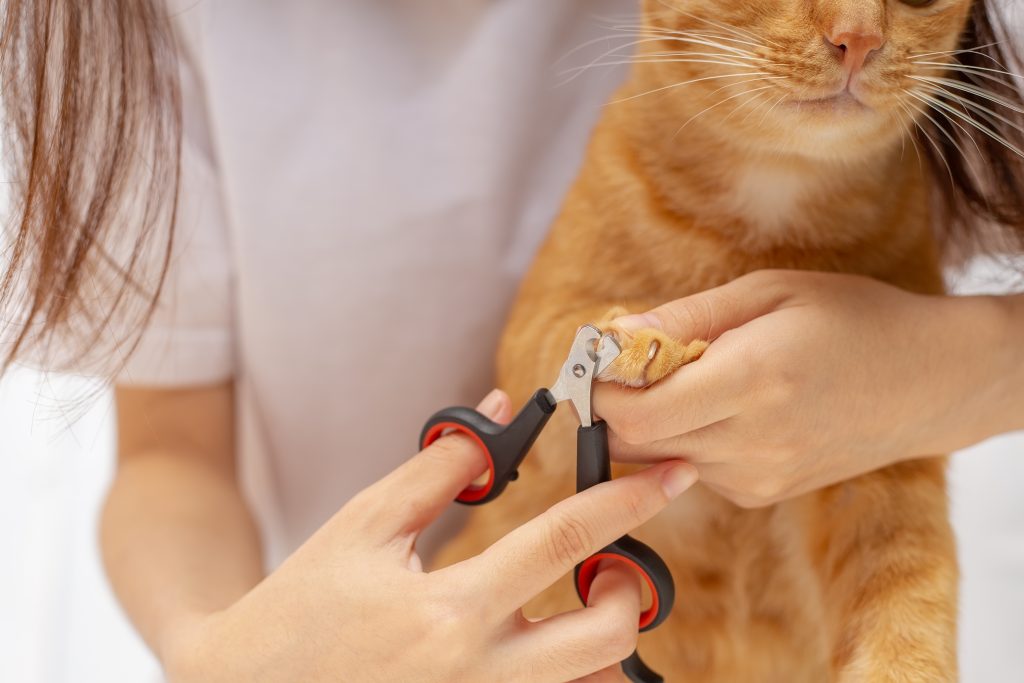
The correct position for holding a cat whilst trimming its claws
Claw Trimming
If your cat lives mostly or exclusively indoors you may need to trim its claws. Living indoors your cat may not have the opportunity to naturally wear the claws down like it would if it were outside. Scratching posts can help with this; however, you may still need to trim down their claws occasionally.
Cats will need to have practice before they are comfortable with you trimming their claws, and even then most cats don’t like it very much!
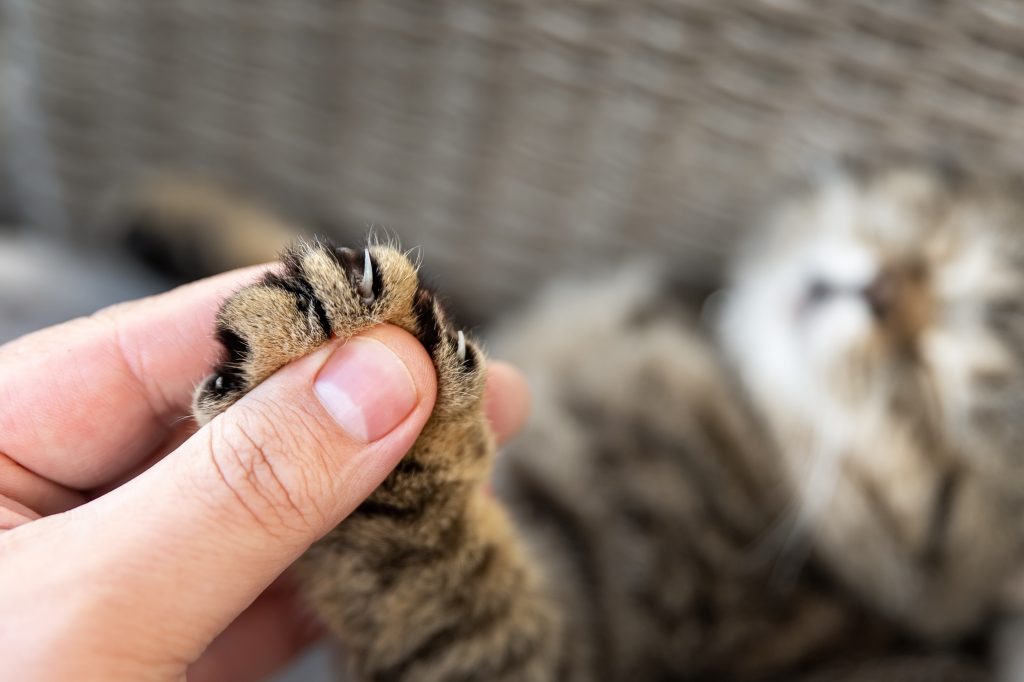
Gently squeeze the cats toe to extend the claw
It helps to have your cat standing on a table and facing away from you. Reach over your cat and pick up its paw, lifting it towards you. Extend the nail by gently squeezing the toe between your thumb and forefinger. It is most important that you trim well clear of the quick; which is the pink blood vessel you can see through the nail. If you do cut the quick it will bleed and hurt your cat.
If you don’t feel confident about trimming your cat’s claws yourself, you can ask your vet to do it during a regular check-up.
Face and Ear Cleaning
Some cats will form discoloration or discharge around the eyes. You can clean this by dampening a soft cloth and gently wiping the area.
It’s important to regularly check your cat’s ears. If your cat is scratching and shaking its head frequently and you notice dark-coloured wax, then it’s possible your cat is suffering from ear mites. This will need to be treated by a vet.
You can clean your cat’s ears by moistening a cotton wool ball with baby oil and gently wiping inside the ear, being careful not to probe or poke inside the ear canal.
Bathing
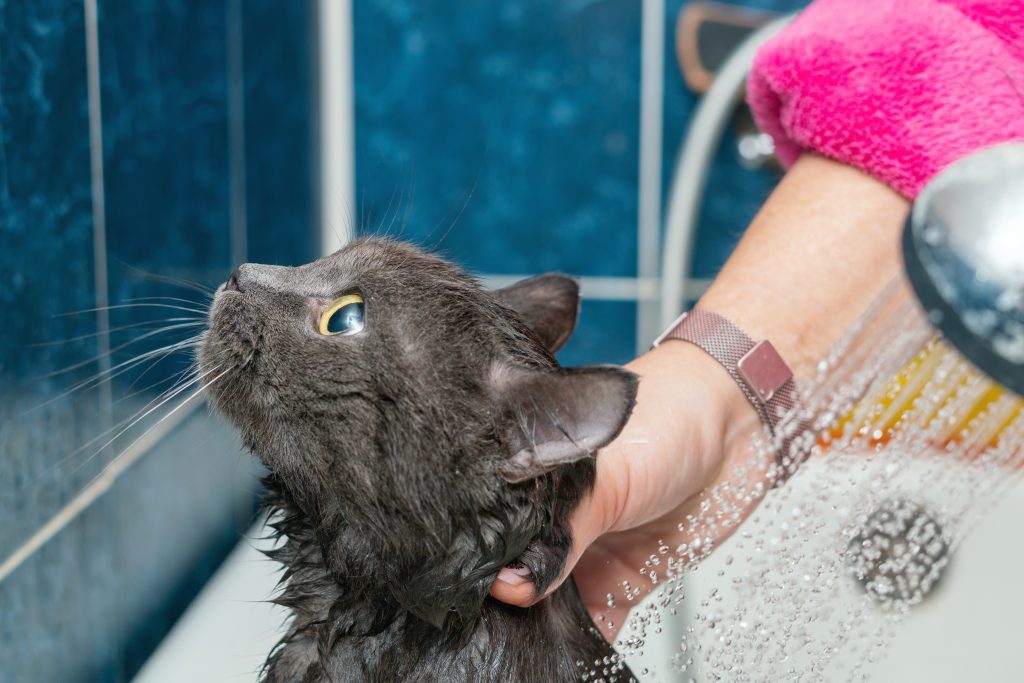
Because cats clean themselves, they only need to be bathed occasionally. Your cat may need a bath if it needs to be flea treated or if it spends a lot of time outside where its coat can get dirty.
Being bathed can be stressful for cats, and it helps if you are well prepared. Follow these steps to ensure that when you bath your cat it is as least stressful as possible.
1. Before you begin, brush your cat’s coat, removing any matting if neede Trim the cat’s nails (if needed) and wipe their ears and eyes as described above.
2. Use a laundry basin, sink or bathtub. It is best to use a basin that is a comfortable height for you so you don’t need to bend over. Close the doors in the bathroom or laundry so your cat can’t escape if they happen to jump out of the basin.
3. Place a rubber mat on the bottom of the basin so your cat doesn’t slip. Attach a spray nozzle to the tap and have the shampoo (specifically for cats) and fresh towels ready at hand. Also have the hand-held hair-dryer ready if your cat is being bathed in cold weather and needs to be dried afterwards.
4. Using the spray nozzle, dampen your cat’s coat from the neck down, avoiding its face. Make sure the water is warm, not hot or cold. Be sure that you do not get any water in the cat’s ears, eyes or nose.
5. Work in the shampoo, being sure to lather in one direction for long- haired cats (this will avoid matting). If you are using a medicated flea shampoo, it will need to be left on the coat for the required time.
6. Rinse the shampoo off the coat, working from the neck down. Wrap your cat in a dry towel and gently squeeze and blot the coat to remove the excess water. Do not ruffle up your cat (such as you might your dog after a bath) as this will only annoy and upset it.
7. If you are going to blow-dry your cat, use a low setting on the hair dryer and gradually work from the rear of the neck downwards. Avoid the face and ears. Make sure the dryer is not on one spot for too long
DIY health checks
Apart from relaxing and calming your cat, stroking and massaging your cat (whilst he’s relaxed) can be used to check your cat’s health and physical condition. You can feel for lumps, skin conditions, dandruff, fleas, ticks or any other infections that may be causing discomfort to your cat. You can also gauge your cat’s reaction when you touch certain areas of the body to check for lumps, sensitive muscles, or limbs that may indicate some stress or some other condition which may occur.
Understanding your cat
The information in this booklet is intended as a general guide only
In order to develop a bond between you and your new cat, you want to make sure that all your interaction with her is positive and rewarding for you both. In order to achieve this you must be able to understand or ‘read’ your cat so that you can gauge what type of interaction they enjoy and what type annoys or frustrates them.
Whilst you will almost certainly never fully understand what is going on inside your cat’s mind, you can gain a general understanding of how she’s feeling by learning and interpreting her body language.
Cat Eyes
Cats reveal their emotion through their eyes. If you wish to make friends with your new cat, try to avoid staring directly at it. Instead, half close your eyes – this is known as a ‘cat smile’ and it will help your cat relax. You can tell your cat is relaxed because it will not have its eyes totally open and will return these ‘cat smiles’ back to you.
If you are interacting with your cat in a relaxed way (ie stroking, massaging, or cuddling) and her eyes suddenly become very dilated (see left), stop what you are doing and ignore the cat for a few minutes. Dilated pupils can be a sign that the cat is frightened, frustrated or over excited (and may start to ‘play’ bite). A relaxed cat will not have dilated pupils unless the light levels are very low or they are unwell.
A sudden narrowing or widening of the pupils can indicate anger and fear, but it can also indicate that they have a sudden interest in something around them. This means that a cat’s pupils dilate when they are feeling negative emotions, but also when they become outside in the sunlight, so its eyes are narrowly dilated.
The Ears, Whiskers and Tail
The ears, whiskers and tail will give you further clues as to what a cat may be feeling.
Ears
Cats have between twenty and thirty muscles in the ears, making the ears very useful for communicating. Cats can also swivel their ears in a half circle, and can move each one by itself. When a cat is relaxed, its ears will sit slightly back on its head or in an upright position. If it is in an excited or alert state the ears will spring forward and if frightened or threatened the ears will sit flat and back against the head.
Whiskers
When a cat is relaxed, its whiskers will be held back flat against the face and when fearful, the whiskers will be pulled back even further. When a cat is in an excited or playful state, ready to pounce on something, it will bring its whiskers forward and puff up its face, and focus on the object they are about to pounce on.
Tail
The way in which a cat holds its tail is also a very important judge of how it’s feeling. When relaxed, a cat will hold its’ tail upright with a slight kink (or ‘bend’) in the end. This is a friendly, social greeting. However, when a cat is playful, excited, cautious or actively checking out what’s going on around it, it will hold its tail lower to the ground and may swish it horizontally from side to side.
Touching and ‘Patting’
Touch is used in many types of healing therapies for both humans and many types of animals. It is a very useful tool for helping cats to relax, however the type of touch and when it is applied is critical in how effective it is in calming a cat. Stroking a cat all over gently may sooth a cat, but if done for too long, it may over-stimulate and annoy the cat. It is important to read the cat’s body-language (as described above) whilst massaging or patting your cat.
How to touch your cat
Cats are very sensitive on particular areas of their body such as their stomachs, back legs and around the base of the tail, so avoid touching these areas. Cats can get over-stimulated quickly, so it’s best to keep touch or patting sessions to less than 10 minutes. Cats also prefer to have interaction often and in short bursts rather than long sessions less often.
The safest place to touch cats is around their ears, head, and chest and chin area. Most cats will enjoy long strokes along the body, but be careful not to over-pat this way; two or three long strokes is enough, then allow the cat to approach you and pat it on the head or chin.
How your cat touches you
Your cat will touch you in different ways. If she is rubbing the side of her face on you, then she is marking you with her scent. Scent is a very important communication tool for cats; however it is not how they greet each other socially. Friendly greeting behaviour involves head butts, touching with the top of the head, body rubs, as well as tails held high with a slight kink at the end.
If you find that your cat begins to circle you or becomes vocal whilst you are patting it, you may get a ‘love bite’. This is when a cat gets over-stimulated and releases that energy with a small bite. You can try and avoid your cat getting to this stage by keeping touch sessions short. If a cat that you are patting begins behaving this way, say nothing, distract it with a toy and throw the toy away from you so that the cat will chase it and you can move away.
It is not a good idea to encourage ‘rough play’ in your cat or kitten. This can lead to anti-social behaviour where she bites every time you try to pat her. This may be cute and manageable in a small kitten, but try having your hand attacked by a full grown cat – not much fun!
If you can learn these body language signals, you will be able to understand how your cat is feeling, which will in turn allow you to bond more strongly with you new cat and make it easier for her to bond with you.
Bad Behaviour
If your cat is a kitten when you adopt him or her, it is very important to immediately establish ‘house rules’ and the kind of behaviour that is and is not acceptable.
For example, if the idea of an adult cat jumping up on the kitchen bench is undesirable to you, then do not allow your cat to do so when he is a kitten! Behaviours such as jumping up on the bench are established during kitten-hood and often difficult to break once formed.
Similarly, allowing your kitten to ‘play fight’ with your hand, foot, arms, or any other part of your body will also establish bad behaviours. This kind of play will teach your cat that it’s okay (and even fun!) to play rough with humans. Whilst this type of behaviour may seem cute in a kitten, it’s not so fun as the kitten grows into a cat and you find yourself fending off his pin-sharp teeth and claws whilst trying to engage in some innocent play!
Teaching ‘no rough play’
Rough play is best left to kittens and cats to engage in with each other, where it is a natural behaviour and important for their development. If your kitten does start to play ‘rough’ with you, there are a few steps you can take to help him understand that the behaviour is unacceptable.
First and foremost – NEVER HIT YOUR CAT! Hitting your cat or kitten will do nothing except teach it to be fearful of you (and eventually all humans).
Rough play can often carry on from a cuddling or play session, when it seems that your cat has suddenly ‘turned’ on you and starts attacking you. This may mean that your cat has become ‘over-stimulated’ (see above in ‘how to touch your cat’). The best way to deal with this is to immediately remove either yourself or your cat from the situation.
Distract your cat with a toy or a loud noise and then quickly walk away from him, ignoring him if he follows you. If he continues to follow you around, then shut him in another room for a brief ‘time-out’ until he calms down.
Modifying unwanted behaviours
If your cat or kitten is engaging in behaviour that you find unacceptable (such as jumping up on the bench, scratching the lounge etc) you can stop the behaviour by using one of the following behaviour modification techniques:
Spray bottle:
Fill a spray bottle with water and using the ‘jet’ spray setting, spray your cat (not near the face) AS SOON AS you see him begin to engage in the unwanted behaviour. The jet spray should startle your cat enough to stop the behaviour as long as you can catch him at the right moment. There is no use spraying him after the fact (even if it is only a few minutes or seconds after).
Loud noise:
Roll up a newspaper and as with the technique above, when you catch him engaging in the unwanted behaviour smack the newspaper down on a hard surface (such as the kitchen bench or the table) in order to make a loud startling noise.
With both of these techniques, they must be repeated a few times, each at the exact time that the cat is engaging in the behaviour. Also, it is extremely important that you either spray the water or make the loud noise at a distance from your cat. You want your cat to correlate these startling occurrences with the behaviour they are engaging in at the time, NOT with you!
Enrichment for cats
TOUCH ENRICHMENT
Touch is used in many types of healing therapies for both humans and many types of animals. It is a very useful tool for helping cats to relax, however the type of touch and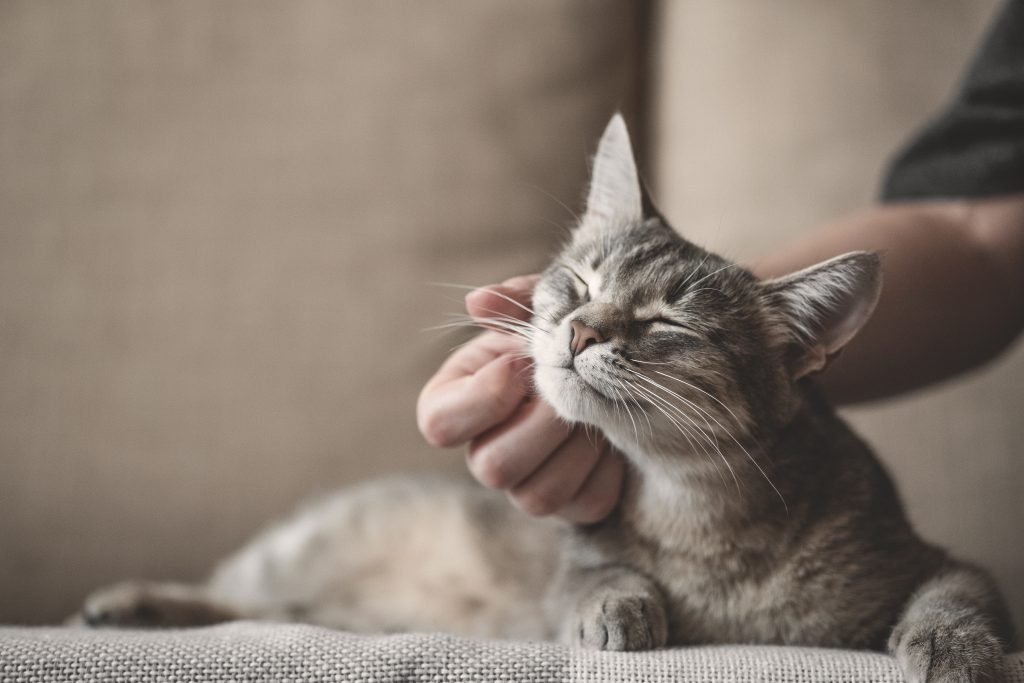 when it is applied is critical in how effective it is in calming a cat. Stroking a cat all over gently may sooth a cat, but if done for too long, it may over-stimulate and annoy the cat. It is important to read the cat’s body-language (as discussed above) whilst applying any touch therapy or massage in order to get the most out of it.
when it is applied is critical in how effective it is in calming a cat. Stroking a cat all over gently may sooth a cat, but if done for too long, it may over-stimulate and annoy the cat. It is important to read the cat’s body-language (as discussed above) whilst applying any touch therapy or massage in order to get the most out of it.
How to touch cats
Cats are very sensitive on particular areas of their body such as their stomachs, back legs and around the base of the tail, so avoid touching these areas. Cats can get over-stimulated quickly, so it’s best to keep touch or massage sessions to less than 10 minutes. Cats also prefer to have interaction often and in short bursts than long sessions less often.
The safest place to touch cats is around their ears, head, and chest and chin area. Most cats will enjoy long strokes along the body, but be careful not to over-pat this way; two or three long strokes is enough, then allow the cat to approach you and pat it on the head or chin.
How cats touch you
Cats will touch you in different ways. If they are rubbing the side of their face on you, then they are marking you with their scent. Scent is a very important communication tool for cats; however it is not how they greet each other socially. Friendly greeting behaviour involves head butts, touching with the top of the head, body rubs, as well as tails held high with a slight kink at the end.
If you find that a cat begins to circle you or becomes vocal whilst you are patting it, you may get a ‘love bite’. This is when a cat gets over-stimulated and releases that energy with a small bite. You can try and avoid cats getting to this stage by keeping touch sessions short. If a cat that you are patting begins behaving this way, say nothing, distract it with a toy and throw the toy away from you so that the cat will chase it and you can move away.
Touch and Massage Techniques
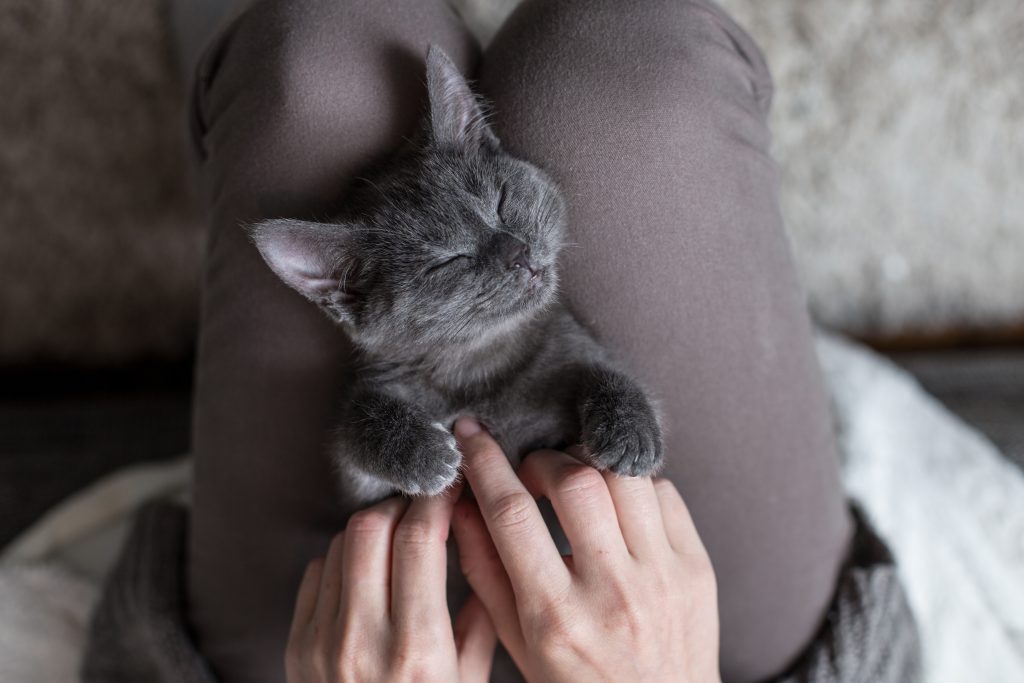
There are a number of different techniques you can use to touch and massage a cat. Remember to always touch in the direction of the fur! Here are some of the touch techniques that you can try using an open palm and fingers and stroking slowly and lightly over the body.
Fingertip
Three fingers together moving in a circular motion over the muscles
Petrissage
skin rolled between finger and thumb and kneed it over tendons, muscles, and ligaments into the muscle below the skin
Friction
smooth and fast strokes with the ball of several fingers
FOOD ENRICHMENT
Cats were designed to hunt and use their sensory abilities, including sight, hearing and their problem-solving minds. However, we bore them to bits by feeding them food which does not move and we give it to them at the same time everyday, in a bowl. How boring! Cats need to be challenged to keep their minds and their bodies healthy. An excellent way to do this is to use food enrichment tools.
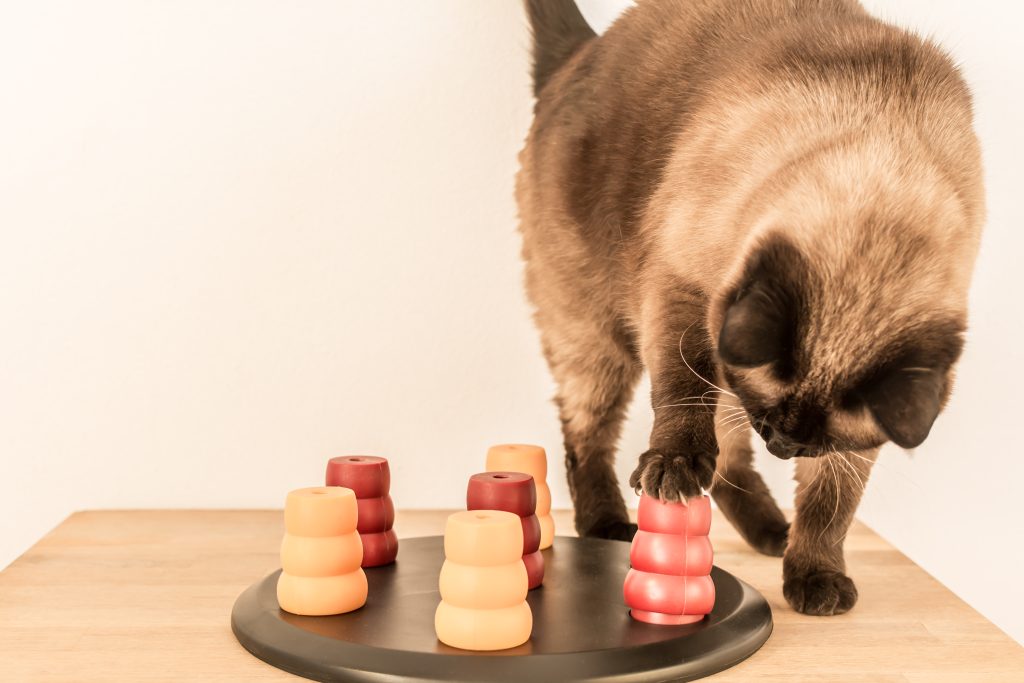 This is a great way to get a cat to use its brain – it is a feeding method that is often used in zoos for the same reason. To scatter feed simply take a portion of the cat’s daily dry feed and scatter it on the floor in front of the cat. Before you scatter the food, get your cat to focus on you so they can see where you place the food. Cats are attracted to movement, so this will also encourage them to go for the food.
This is a great way to get a cat to use its brain – it is a feeding method that is often used in zoos for the same reason. To scatter feed simply take a portion of the cat’s daily dry feed and scatter it on the floor in front of the cat. Before you scatter the food, get your cat to focus on you so they can see where you place the food. Cats are attracted to movement, so this will also encourage them to go for the food.
Kongs and Activity Balls
These are specially made food enrichment tools. They come in a variety of sizes, colours and patterns. They work by placing dry food inside, and as the cat rolls it around, the food falls out.
Bottles
This is like a home-made Kong. All you need to do is get a used water bottle that has been completely wash and dried out with all the labels taken off. Make a few holes around the outside, large enough so the dry food kibble could fall out (but not too large so it pours out!). You’ll need about 10 holes in it for beginner cats. Fill the bottle half up with dry food, put the lid on and give it to the cat.
Feeding Pyramids
This feeding method provides excellent mental stimulation for a cat. You can make a feeding pyramid at home, all you need are 6 empty toilet rolls and some masking or sticky tape. Stack the toilet rolls like a pyramid – three rolls to make a bottom row, two rolls for the next row on top and one roll on the top (see diagram below). Place a few dry cat food treats or a portion of the cat’s dry feed in each roll. At first, place the food near the opening of each roll, then gradually as the cat gets used to this method of feeding, push the food further in so it is more challenging for the cat to reach.
PLAY ENRICHMENT
Play is a fantastic way to bond with adult cats as well as kittens. It is important stimulation and exercise for your cat and is a great for releasing frustration, boredom communication and learning.
Play is a tool to help not only the cat, but also the relationship between cat and human companion. In play, a relationship develops between the cat and the person, with the person entering the cat’s world and following the cat’s lead, helping to form a relationship of trust.
Homemade Cat Toys
You don’t need to spend a lot of money to provide play toys for cats. You can easily make them at home from recycled materials. Below are some examples:
Paper Ball
Take an A4 piece of scrap paper and roll it tightly between your palms. The ball works best on a hard surface such as tiles or a wooden floor. Roll the paper ball along the floor near the cat until it attracts its attention. Once the cat notices the ball he will probobly start chasing it and batting it between his front paws.
Ping Pong Cat Ball
Ping pong balls make the perfect toy for your cat. He will just love chasing it along the floor (especially if it is a hard surface such as a polished wooden florr.) Because they are small however, they will easily get lost under furniture, so you may need to buy a few.
Paper Bag Toy
Find a paper shopping bag (NOT a plastic one!) and leave it open somewhere in the middle of the room. Cats are very curious and love to investigate anything new in the room. It won’t take long for your cat to come over and begin to inspect the paper bag and then start to have a play around with it.
String Cat Toy
All cats love to chase a bit of dangling string. You can use any piece of string such as wool or twine, but you must always be there to drag the string along – never leave your cat alone to play with the string, as he could get caught up and choked by it.
ENVIRONMENTAL ENRICHMENT
Climbing, Heights and Hiding
Cats love to climb and perch up high. You can allow your cat to climb onto furniture or shelving or get specially made cat climbing equipment such as a cat scratching post. Cats don’t see their environment in two dimensional spaces as we do, they see it three dimensionally and are always looking for ways to use all the space in their environment.
Help them explore by providing access to heights. Heights can also help insecure cats feel more relaxed. Combine heights with hiding spots to provide a stimulating environment. If you have more than one cat, provide many perching areas around your home.
Cut a hole in the side so the cat can squeeze in side and then some holes in the side or top of the box so you can poke toys through or dangle string for a fun play session!
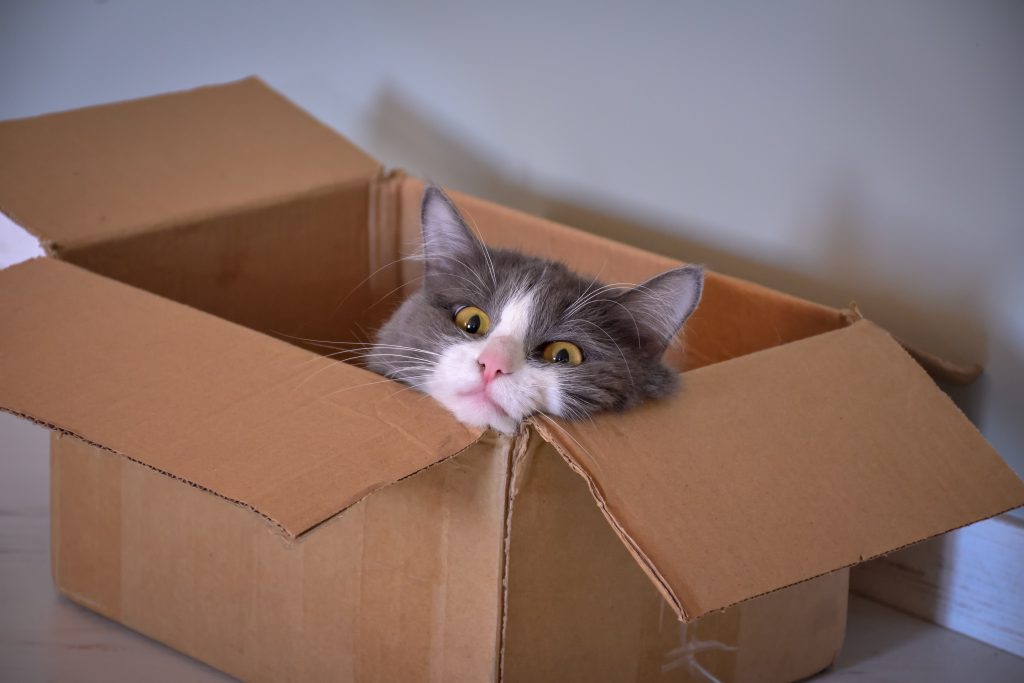
Introducing your new cat to your dog
INTRODUCING YOUR NEW CAT TO YOUR DOG
The information in this booklet is intended as a general guide only
Preparing your home
Before you even bring your new cat home, prepare him a room of his own with his own bedding, food bowls and litter tray. A bedroom, laundry or bathroom is suitable, but it must have a closable door.
Keep doors and windows closed and make sure there aren’t any crawl spaces or holes where they can escape to and that you can’t access.
Isolating the new cat dog tells your resident dog that not all of the house and territory has been invaded.
Arriving home
Introducing a new cat into a household with an existing dog isn’t always easy. Above all, you will need patience and don’t expect them to be best friends right away. As friendly as your dog maybe, your cat may never learn to love him and indeed may always despise the household canine.
Send your dog outside of the house and let him see you carry the cat crate inside so he knows his human leader approves. He won’t make as big of a fuss if he finds the cat already in the house.
Cats normally posture or hiss; while dogs typically sniff, whine, growl or bark at the new arrival. Allow the cat several days to settle and adjust to being in a new environment, interacting with just you and your family in its ‘safety’ room.
Allowing your new cat to explore your home
Keeping the door closed to the cat’s safety room helps prevent sensory overload. The new cat and existing dog can gradually get used to each other by communicating only by scent and sound.
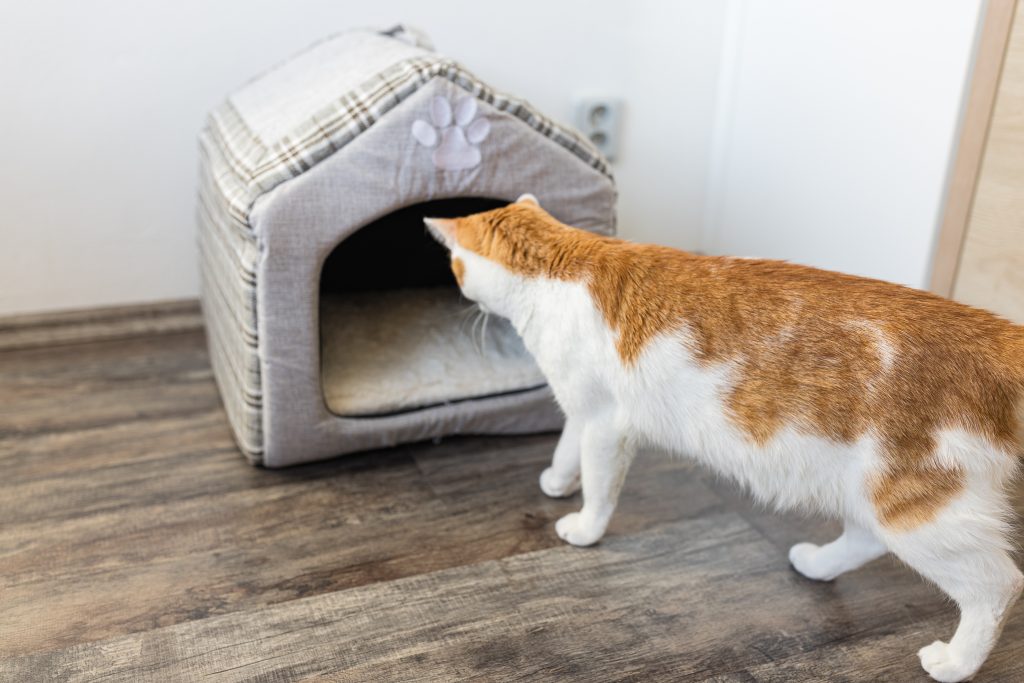
Young domestic bicolor orange and white cat checking soft indoor cat house for hiding or sleeping place. Cat habits and love for small cozy spaces concept. Close up, selective focus, copy space[/caption]Once a few days have passed and the growls or hisses fade, swap items that each pet has scented so they have a closer sniffing opportunity to get acquainted. For instance, bring out the food bowl each has emptied to allow the other critter to smell.
After a few days the new cat will need an opportunity to wander around the rest of the house and become comfortable with its surroundings.
Remember, cats aren’t interested in meeting new friends until they know all the good hiding places and have cheek-rubbed and mapped the territory.
Send your dog into the yard during the cat’s exploration, or shut the dog inside the new cat’s room so he can sniff where she’s been.
Allow the cat time to explore the entire house, while keeping a close eye and monitoring its response and body language.
A partial introduction
You can now consider installing a baby gate in the isolation room so the pets can see and sniff each other, and meet at their own speed, but through the safety of the barrier 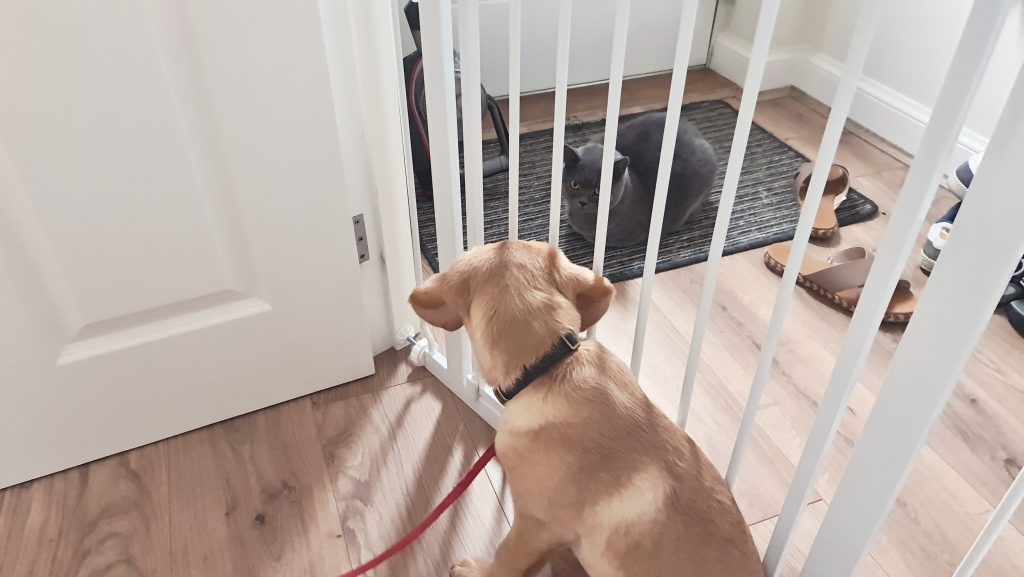
Use scent to speed up acceptance. Rub a towel over both pets–first one and then the other–to share their own signature scent.
Let them get to know each other in their own time with the dog firmly under control – don’t push them toward each other or force interaction.
Feel encouraged once the barking and hissing fade, especially if the canine “play-bows” at the door or the pair play patty-cake-paws under the barrier/door.
Meeting face to face
Don’t leave them alone together until they are comfortably interacting in the same room. Give your dog extra affection to avoid jealousy.
Keep the dog on a leash so you can watch its reaction when first introducing them to your cat or kitten.
Supervise them carefully and take your dog away from the cat if it shows aggressive or chasing behaviour with a firm ‘No’ command to your dog.
Your cat/kitten should always have a safe retreat eg high shelf, or a room not accessible to the dog. An adult cat may swat a dog to set limits.
Take your time, and practice patience during introductions. Proper introductions will ensure your cat and dog enjoy their future together, in your very own peaceable kingdom.
Cat Behaviour Issues?
Has your cat changed its toileting behaviour?
CHANGES IN TOILETING BEHAVIOUR
The information in this booklet is intended as a general guide only
A cat is usually fastidious about it habits and will consistently use a litter tray indoors. If your cat regularly toilets (away from a litter box) or sprays indoors, it is certainly cause for concern. First you must ascertain if your cat is urinating or spraying inside.
The occasional one-off accident may happen if cat is unwell, is suddenly frightened or stressed a particular event. However if toileting around the home persists, the cause should be investigated, both for the health and welfare of the cat, and also for your own convenience.
Whatever the cause, punishment is not the answer this will only make the cat more fearful and the problem worse.
Urinating or spraying; which is it?
To urinate a cat squats and deposits a volume of urine on horizontal surface such as a little tray or garden bed. To ‘spray’ urine the cat stands up, making a treading motion with its back feet, the tail will quiver and a small amount of urine will ‘spray’ backwards onto vertical surface such as a wall, leaving a scent mark.
SUDDEN CHANGES
Stress or Medical Problems
A cat that consistently urinates inappropriately in the house should be taken to the vet for a medical checkup. Urinary tract problems can be attributed to stress among other causes. Infection or irritation can make a cat urinate when standing and sometimes this can be confused with spraying. Your Vet will diagnose the problem and may advise you to change your cat’s diet and increase water intake.
Common causes and action checklist
- Cats don’t like using a litter tray if it is heavily soiled. Clean the litter tray out completely every couple of days.
- A change of litter type or brand can also upset your cat’s toileting routine. Scented litter, deodorants, disinfecting especially with liquids that contain Phenols (toxic to cats) can really impact of their choice to use their litter tray. Also a change in the texture of a litter can deter a cat from using it.
- Cats are private creatures when it comes to toileting, they do not like their litter trays positioned in an open area, it makes them feel vulnerable. Also the damp and noise of washing machines and dryers can also impact a cat’s toileting.
- Place the litter tray in a quiet corner where the cat only has to watch one or two directions at once, and ensure there is one litter tray per cat.
- Also placing food and water near a litter tray will put a cat off.
- Type of litter tray must be considered. There are both covered and open style litter trays. Some cats prefer open trays as it gives them more options for escape while other cats prefer the covered (hatch style) as it offers them privacy and security.
- Also consider the size of litter tray – does it suit the size of your cat? A big cat will need a larger litter tray. A tray with higher sides may also prevent urination outside the box. Try a storage container crate minus the clip on lid for a cheap and good sized litter tray.
- Occasionally a cat decides not to use a litter tray because of a bad association. This could be because of a scare, being interrupted while using the litter tray, or being medicated while in the tray. Re-positioning the tray to an even quieter place may help.
- Urinary Tract Infection or diarrhea means your cat needs to visit your Veterinary surgery.
- Visitors to your house, young children and a house sitter can all have an effect on your cat. They can experience fear and anxiety and or can even experience ‘separation anxiety’ from their owners.
- The presence of a stranger caring for them can cause some cats to ‘mark’ their territory as a result of feeling extremely threatened especially in areas such as their owner’s bedroom. Positioning of additional litter trays in safe rooms may help.
- Changes within the house can also contribute to a Cat ‘spraying’ or changing its toileting behavior. For example if there is a new person living in the home, building work being done, redecoration inside the house or a change in the household routine.
Old age
As cats get older they respond to their territory in a more sensitive way. The presence of other cats in their area may impact on their toileting confidence, as can bad weather and the use of cat flaps.
Cleaning Solutions
If you have reviewed the potential causes for the change in your cats toileting behavior and eliminated obvious causes for concern, then making them feel more secure may help with your cat’s general well being.
You can reduce the area your cat has to patrol to reduce its stress levels. Bring the area down to say one or two rooms to reduce the desire to ‘mark’.
Feliway – a synthetic feline pheromone can be used to mimic the scent produced from the glands on a cats face. There is a diffuser version that can be plugged in at floor level where the cat has been most active with the ‘spraying’ behavior.
If you catch your cat ‘spraying’ then you should clean and de-scent the area as quickly as possible.
- Wipe away the deposited spray “marking” urine
- Use hot water to clean the space ‘marked’
- Wipe area down with (Surgical Spirit); Methylated Spirits and allow it to evaporate
- The ‘Feliway’ can then be applied sparingly twice a week, for a week or the diffuser can utilized. Placing small bowels of food at the ‘marking’ site can also enhance the positive reaction to that area by the cat.
Has your cat stopped using the litter tray
LITTER TRAY PROBLEMS
At least 10% of all cats develop elimination problems. Some stop using the box altogether. Some only use their boxes for urination or defecation but not for both. Still others eliminate both in and out of their boxes. Elimination problems can develop as a result of conflict between multiple cats in a home, as a result of a dislike for the litter-box type or the litter itself, as a result of a past medical condition, or as a result of the cat deciding she doesn’t like the location or placement of the litter box.
Once a cat avoids her litter box for whatever reason, her avoidance can become a chronic problem because the cat can develop a surface or location preference for elimination—and this preference might be to your living room rug or your favourite easy chair. The best approach to dealing with these problems is to prevent them before they happen by making your cat’s litter boxes as cat- friendly as possible. See our common litter-box management issues below, and our ways to make litter boxes cat-friendly. It is also important that you pay close attention to your cat’s elimination habits so that you can identify problems in the making. If your cat does eliminate outside her box, you must act quickly to resolve the problem before she develops a strong preference for eliminating on an unacceptable surface or in an unacceptable area.
Litter box use problems in cats can be diverse and complex. Behavioural treatments are often effective, but the treatments must be tailored to the cat’s specific problem. Be certain to read the entire article to help you identify your particular cat’s problem and to familiarize yourself with the different resolution approaches to ensure success with your cat.
WHY DO SOME CATS ELIMINATE OUTSIDE THE LITTER BOX?
Litter-Box Management Problems
If your cat isn’t comfortable with her litter box or can’t easily access it, she probably won’t use it. The following common litter-box problems might cause her to eliminate outside of her box:
- You haven’t cleaned your cat’s litter box often or thoroughly enough.
- You haven’t provided enough litter boxes for your household. Be sure to have a litter box for each of your cats, as well as one extra.
- Your cat’s litter box is too small for her.
- Your cat can’t easily get to her litter box at all times.
- Your cat’s litter box has a hood or liner that makes her uncomfortable.
- The litter in your cat’s box is too deep. Cats usually prefer one to two inches of litter.
Surface Preference
Some cats develop preferences for eliminating on certain surfaces or textures like carpet, potting soil or bedding.
Litter Preference or Aversion
As predators who hunt at night, cats have sensitive senses of smell and touch to help them navigate through their environment. These sensitivities can also influence a cat’s reaction to her litter. Cats who have grown accustomed to a certain litter might decide that they dislike the smell or feel of a different litter.
Location Preference or Aversion
Like people and dogs, cats develop preferences for where they like to eliminate and may avoid locations they don’t like. This means they might avoid their litter box if it’s in a location they dislike.
Inability to Use the Litter Box
Geriatric cats or cats with physical limitations may have a difficult time using certain types of litter boxes such as top-entry boxes, or litter boxes with high sides.
Negative Litter-Box Association
There are many reasons why a cat who has reliably used her litter box in the past starts to eliminate outside of the box. One common reason is that something happened to upset her while she was using the litter box. If this is the case with your cat, you might notice that she seems hesitant to return to the box. She may enter the box, but then leave very quickly—sometimes before even using the box.
One common cause for this is painful elimination. If your cat had a medical condition that caused her pain when she eliminated, she may have learned to associate the discomfort with using her litter box. Even if your cat’s health has returned to normal, that association may still cause her to avoid her litter box.
Household Stress
Stress can cause litter-box problems. Cats can be stressed by events that their owners may not think of as traumatic. Changes in things that even indirectly affect the cat, like moving, adding new animals or family members to your household—even changing your daily routine—can make your cat feel anxious.
Multi-Cat Household Conflict
Sometimes one or more cats in a household control access to litter boxes and prevent the other cats from using them. Even if one of the cats isn’t actually confronting the other
cats in the litter box, any conflict between cats in a household can create enough stress to cause litter-box problems.
Medical Problems That Can Cause Inappropriate Elimination
MEDICAL PROBLEMS THAT CAN CAUSE INAPPROPRIATE ELIMINATION
Urinary Tract Infection (UTI)
If your cat frequently enters her litter box and seems to produce only small amounts of urine, she may have a urinary tract infection. See a veterinarian to rule out this possible medical problem.
Feline Interstitial Cystitis
Feline interstitial cystitis is a neurological disease that affects a cat’s bladder (“cystitis” means inflamed bladder). Cats with cystitis will attempt to urinate frequently and may look as if they are straining, but with little success. They may lick themselves where they urinate, and they may have blood in their urine. Feline interstitial cystitis can cause a cat to eliminate outside of her box, but this is only because of the increased urgency to urinate and because there is pain involved in urination. Feline interstitial cystitis is very serious and can be life-threatening to the cat. It must be treated immediately by a veterinarian.
Kidney Stones or Blockage
If your cat has kidney stones or a blockage, she may frequently enter her litter box. She may also experience pain and meow or cry when she tries to eliminate. Her abdomen may be tender to the touch.
OTHER BEHAVIOUR PROBLEMS TO RULE OUT
Urine Marking
Urine marking is a problem that most pet owners consider a litter box problem since it involves elimination outside the box, but the cause and treatment are entirely different from other litter-box problems and therefore it is considered a rule out. A cat who urine marks will regularly eliminate in her litter box, but will also deposit urine in other locations, usually on vertical surfaces. When marking, she’ll usually back up to a vertical object like a chair side, wall or speaker, stand with her body erect and her tail extended straight up in the air, and spray urine onto the surface. Often her tail will twitch while she’s spraying. The amount of urine a cat sprays when she’s urine marking is usually less than the amount she would void during regular elimination in her box. For more information about this problem, please see our article,Urine Marking in Cats.
WHAT TO DO IF YOUR CAT ELIMINATES OUTSIDE THE LITTER BOX
Basic Tips for Making Cats Feel Better About Using Their Litter Boxes
- Virtually all cats like clean litter boxes, so scoop and change your cat’s litter at least once a day. Rinse the litter box out completely with baking soda or unscented soap once a week.
- The majority of cats prefer large boxes that they can enter easily. Plastic sweater storage containers make excellent litter boxes.
- Most cats like a shallow bed of litter. Provide one to two inches of litter rather than three to four inches.
- Most cats prefer clumping, unscented litter.
- Your cat may prefer the type of litter she used as a kitten.
- Most cats don’t like box liners or lids on their boxes.
- Cats like their litter boxes located in a quiet but not “cornered” location. They like to be able to see people or other animals approaching, and they like to have multiple escape routes in case they want to leave their boxes quickly.
- Because self-cleaning boxes are generally cleaner than traditional types of litter boxes, many cats accept them readily. However, if you’re using a self-cleaning litter box and your cat starts eliminating outside the box, try switching to a traditional type of litter box.
Resolving a Litter-Box Problem
The first step in resolving elimination outside the litter box is to rule out urine marking and medical problems. Have your cat checked thoroughly by a veterinarian. Once your veterinarian determines that your cat doesn’t have a medical condition or issue, try following these guidelines:
- Provide enough litter boxes. Make sure you have one for each cat in your household, plus one extra. For example, if you have three cats, you’ll need a minimum of four litter boxes.
- Place litter boxes in accessible locations, away from high-traffic areas and away from areas where the cat might feel trapped. If you live in a multistory residence, you may need to provide a litter box on each level. Keep boxes away from busy, loud or intimidating places, like next to your washer and dryer or next to your dog’s food and water bowls, or in areas where there’s a lot of foot traffic.
- Put your cat’s food bowls somewhere other than right next to her litter box.
- Remove covers and liners from all litter boxes.
- Give your cat a choice of litter types. Cats generally prefer clumping litter with a medium to fine texture. Use unscented litter. Offer different types of litter in boxes placed side-by-side to allow your cat to show you her preference.
- Scoop at least once a day. Once a week, clean all litter boxes with warm water and unscented soap, baking soda or no soap, and completely replace the litter. The problem with scented cleaners is that your cat could develop an aversion to the scent.
- Clean accidents thoroughly with an enzymatic cleanser designed to neutralize pet odours. You can find this kind of cleaner at most pet stores.
- If your cat soils in just a few spots, place litter boxes there. If it’s not possible to put a box in a spot where your cat has eliminated, place her food bowl, water bowl, bed or toys in that area to discourage further elimination.
- Make inappropriate elimination areas less appealing. Try putting regular or motion- activated lights in dark areas. You can also make surfaces less pleasant to stand on by placing upside-down carpet runners, tin foil or double-sided sticky tape in the area where your cat has eliminated in the past.
If Your Cat Has Developed a Surface or Location Preference
If your cat seems to prefer eliminating on a certain kind of surface or in a certain location, you’ll need to make that surface or its location less appealing. If the preference is in a dark area, try putting a bright light or, even better, a motion-activated light in the area. You can also make surfaces less pleasant to stand on by placing upside-down carpet runners, tin foil or double-sided sticky tape where your cat has eliminated in the past. At the same time, provide your cat with extra litter boxes in acceptable places in case part of her problem is the location of her usual litter box, and be sure to give her multiple kinds of litter to choose from so that she can show you which one she prefers. Put the boxes side-by-side for a while, each with a different type of litter, and check to see which one your cat decides to use.
Clean accidents thoroughly with an enzymatic cleanser designed to neutralize pet odours. You can find this kind of cleaner at most pet stores.
If Your Cat Has Developed a Litter Preference or Aversion
Cats usually develop a preference for litter type and scent as kittens. Some cats adapt to a change of litter without any problem at all, while other cats may feel uncomfortable using a type of litter that they didn’t use when they were young.
If you think your cat may dislike her litter type, texture or smell, try offering her different types of litter to use. Cats generally prefer clumping litter with a medium to fine texture. They also usually prefer unscented litter. To help your cat pick her preferred litter, put a few boxes side-by-side with different types of litter in them. She’ll use the one the she likes best.
Clean accidents thoroughly with an enzymatic cleanser designed to neutralize pet odours. You can find this kind of cleaner at most pet stores.
If Your Cat Is Unable to Use Her Litter Box
Special-needs cats such as those who are older, arthritic or still very young might have trouble with certain types of litter boxes. Boxes that have sides that are too high or have a top-side opening might make it difficult for your cat to enter or leave the box. Try switching to a litter box with low sides.
As in any situation where the cat may have eliminated outside her box, clean accidents thoroughly with an enzymatic cleanser designed to neutralize pet odours. You can find this kind of cleaner at most pet stores.
Treatment for Negative Litter Box Association
If your cat has experienced some kind of frightening or upsetting event while using her litter box, she could associate that event with the litter box and avoid going near it. Things that might upset your cat while she’s eliminating in her box include being
cornered or trapped by a dog, cat or person, hearing a loud noise or commotion, or seeing something frightening or startling. These experiences—or any other disturbing experience—could make your cat very reluctant to enter her litter box. If your cat is afraid of her litter box, you may notice her running into the box and then leaving again very quickly, sometimes before she’s finished eliminating. You may also notice her eliminating nearby, but not inside her box. This means that your cat is worried about using her box, especially if she has reliably used litter box in the past.
CHANGING THE WAY YOUR CAT FEELS
If your cat associates her litter box with unpleasant things, you can work to help her develop new and pleasant associations. Cats can’t be forced to enjoy something, and trying to show your cat that her litter box is safe by placing her in the box will likely backfire and increase her dislike of the box. It’s usually not a good idea to try to train your cat to use her litter box by offering her treats like you would a dog, because many cats do not like attention while they’re eliminating. However, a professional animal behaviour consultant, such as a Certified Applied Animal Behaviourist (CAAB) or a board-certified veterinary behaviourist (Dip ACVB) may be able to help you design a successful retraining or counter-conditioning program.
Sometimes retraining to overcome litter-box fears or aversions may not be necessary. Here are some steps that you can try to help your cat learn new pleasant associations:
- Move your cat’s litter box to a new location, or add a few litter boxes in different locations at the same time. Pick locations where your cat can see who is approaching from any sides that aren’t backed by walls. These locations should also have multiple escape routes so that your cat can quickly leave her litter box if she suddenly feels anxious. If possible, make sure that children or other animals who might seem threatening to your cat can’t get near her litter box.
- Fill the litter boxes one to two inches deep with a litter that is a little different from the litter in the boxes your cat avoids. Use a finer or coarser texture. If you’ve been using scented litter, try unscented litter.
- Try playing with your cat near her litter box. Also leave treats and toys for her to find and enjoy in the general area leading to her box. Don’t put her food bowl next to the box, though, because cats usually don’t like to eliminate close to their food.
- If you have a long-haired cat, try carefully and gently clipping the hair on her hind end if you notice that it gets soiled or matted during elimination. Matting can cause the hair to get pulled when the cat eliminates. That can be painful for the cat and make her skittish of her litter box.
Treatment for Household Stress
Cats sometimes stop using their litter boxes when they feel stressed. Identify and, if possible, eliminate any sources of stress or frustration in your cat’s environment. For instance, keep her food bowls full and in the same place, keep her routine as predictable as possible, prevent the dog from chasing her, close blinds on windows and doors so she isn’t upset by cats outside. If you can’t eliminate sources of stress, try to reduce them.
Incorporate the use of sprays or diffusers that deliver a synthetic pheromone that has been shown to have some effect in relieving stress in cats.
Treatment for Multi-Cat Household Conflict
Sometimes an elimination problem can develop as a result of conflict between cats who live together. If you have multiple cats and aren’t sure which cat is soiling, speak with your veterinarian about giving fluorescein, a harmless dye, to one of your cats. Although the dye does not usually stain carpeting, it causes urine to glow blue under ultraviolet light for about 24 hours. If you can’t get or use fluorescein, you can temporarily confine your cats, one at a time, to determine which one is eliminating outside of the litter boxes in your home.
If there is a conflict between your cats and one of them seems stressed, provide
additional litter boxes in locations where the anxious cat spends the majority of her time. Also be sure to provide adequate resting areas for each cat. It can very useful in multi-cat households to create vertical resting spots on shelves or window sills or by buying multi- perch cat trees. It may help to distribute resources such as food, water, cat posts or trees, and litter boxes so that each individual cat can make use of them without coming into contact or having a conflict with one of the other cats. Using synthetic pheromone sprays or diffusers can reduce general social stress in your household.
Medications
Always consult with your veterinarian or a veterinary behaviourist before giving your cat any type of medication for a behaviour problem.
Medications can provide additional help in treating inappropriate elimination when the behaviour is in response to stress or anxiety. It’s unlikely to be helpful if your cat eliminates outside her litter box because of litter-management problems, an aversion to a particular kind of litter or location, a preference for a particular surface or location, or a physical inability to use the box. If you’d like to explore this option, speak with your veterinarian, a veterinary behaviourist or a Certified Applied Animal Behaviourist who can work closely with your vet. Please see our article, Finding Professional Behavior Help, to locate one of these professionals in your area
WHAT NOT TO DO
Regardless of what you do so solve your cat’s elimination problems, here are a few things to avoid:
- Do not rub your cat’s nose in urine or faeces.
- Do not scold your cat and carry or drag her to the litter box.
- Do not confine your cat to a small room with the litter box, for days to weeks or longer, without doing anything else to resolve her elimination problems.
- Do not clean up accidents with an ammonia-based cleanser. Urine contains ammonia, and therefore cleaning with ammonia could attract your cat to the same spot to urinate again. Instead, use a product specifically for cleaning pet accidents.
Cat Behaviour and Care
INTRODUCING YOUR NEW CAT TO YOUR EXISTING CAT
The information in this booklet is intended as a general guide only
Introducing a new cat into a household with an existing cat isn’t always easy. Even when we humans have our existing cat’s happiness at heart (ie we’ve adopted the new cat as a ‘friend’ for the old one), first introductions don’t always go as smoothly as we would like! In reality, your existing cat will most probably be a bit stroppy about the new arrival and it will take some time to adjust. When bringing a new cat into your home there are few things you can do, however, to make the adjustment easier for your old cat as well as your new one.
Give them space
Before you even bring your new cat home, prepare him a room of his own with his own bedding, food bowls and litter tray. A bedroom, laundry or bathroom is suitable, but it must have a closable door. It is very important to make sure you do not change your existing cat’s feeding and sleeping arrangements once the new cat arrives, so giving the new cat his own room for a few days will minimise any upset to your old cat’s routine.
When the time to comes to bring your new cat into the home, bring him straight to his ‘room’, open the cat carrier door and allow him to explore his new surroundings. He may hide at first or seem nervous – this is perfectly normal. Do not force him to come out of his hiding spot or to interact and play if he does not want to. Just shut the door and give him some space and quiet time in the room alone to get used to his new home.
Investigating new smells
After a few hours, take a blanket or toy with your new cat’s smell on it and place it in the main living area of your existing cat. Do the same again but taking something with your existing cat’s smell and placing it in your new cat’s room. Allow the two cat’s time to investigate these new smells. Also allow them to sniff each other through the closed door – some hissing may occur, but with the door between them nothing can come of it, so don’t worry!
Time to explore
After a few days, confine your existing cat to the new cat’s room and let your new cat out to explore the rest of the house. Allow each of them time to explore the other’s living areas and get used to one another’s smells. After some time return them to their previous living arrangements and wait another day before allowing them to meet face-toface.
At last we meet!

Above: After a couple of days allow your new cat time to explore her new surroundings.
When you think it’s time to let the two meet face-to-face, put your new cat in a cat carrier and bring him out into your existing cat’s living space. Allow them to sniff at each other through the carrier door at first. There will be some hissing – this is to be expected. Watch carefully and when your old cat seems to have calmed down, open up the carrier door and allow them to roam freely in the same space, under your watchful eye. There will be some stand-offs and it may take quite some time for them to become ‘friends’ (if ever).
Keep your new cat’s room set up as it has been for a few more days to allow him a place to escape if he is getting bullied by your old cat. There is no need to continue to lock him away unless you feel that you cannot trust the two cats together without your supervision. In this case, try not to leave them alone in the same room together until you feel comfortable that they will not fight. When you

Above: Expect some ‘stand-offs’ when your two cats first meet.
do feel at ease, you can then move your new cat’s food bowls and litter tray out of his room and into the main living area with your other cat.
Remember to give your existing cat some extra time, attention and treats to avoid excessive jealousy.
Each to their own
Cats living in multi-cat households MUST each have their own space in which to escape and spend time apart from one another if they so wish. Each cat should also be provided with his own litter tray and food bowls, separate from the other cats’.
It takes time
Whatever you do, DO NOT force the two cats to come together and ‘make friends’. Allow them the time to make up their own minds about each other and accept that some cats will eventually become friends, but some may not. You will need to allow at LEAST TWO WEEKS to judge whether or not they are going to get along, and even if it looks as though the two will not be best friends, this does not mean that they cannot live happily in the same house. Cats are not humans and they are not dogs. They are amazingly good at tolerating others in their environment that they don’t particularly like (just look at all the cats at the Animal Welfare League that are placed in the rehoming pens every day that don’t know each other – they learn to tolerate each other in a surprisingly short period of time!)
As long as you provide each of your cats with their own space (as described above) and don’t place unrealistic ‘human’ expectations on them (i.e. that they have to be best friends otherwise it’s not going to work), they will adapt to their new situation eventually and settle down.

Above: Given time, your two cats may become the best of friends.
DO YOU HAVE AN ESCAPING OR STRAYING CAT?
It used to be that many people thought you couldn’t keep your cat in your own yard. Cats jump fences, don’t they? However, allowing cats to roam usually leads to injury or even death for your cat – on roads, or in fights with dogs and other cats, or through being trapped and taken to the pound. There are thousands of cats who wander and end up in the pound, who are never reclaimed by their owners. These days there are many ways to prevent these dangers and keep your cat safe.
1. BUILD YOUR OWN CAT SAFE FENCE ATTACHMENTS OR CAT ENCLOSURE.
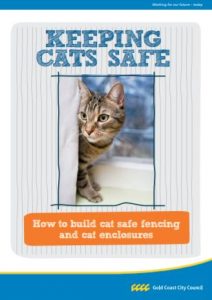
Download the GCCC Keeping Cats Safe guide here.
You can watch how others have built different types of cat safe enclosuresand fencing here.
2. Contact the companies that manufacture fence attachments or enclosures.
Some examples here:
Oscillot Cat Containment Systems
Oscillot is a roller or paddle which attaches to Colorbond or other types of fencing. It rotates when a cat tries to scale the fence, preventing them from scrambling over. It blends in well with most fencing making it very suitable for suburban yards, and rental accommodation. It allows your cat access to the whole yard or part of the yard, if you choose only to fence the back, front or side of the yard. Oscillot prevents cats scaling fences, provided the fence surface does not allow climbing, and does not have a ledge or rail to help them climb over. It works best on any fence that has a smooth surface e.g. Colourbond.
Cat Nets
Suppliers of netting which can be used for fence extensions.
Aussie Cat Enclosures
Suppliers of standardised and customised wire enclosures can fully surround a courtyard, veranda or pergola. Wire enclosures can extend your cat’s access from indoors to outdoors for some sunshine & fresh air.
Catmax in QLD
Suppliers of cat walks, cat netting, and cat tunnels.
Cat Nip Netting
Suppliers of modular enclosures and have installers in Victoria and some other places around Australia
Happy Cat Enclosures
Based in SEQ offer 5% off for customers who foster or adopt a cat!
SecureaKat Cat Runs & Enclosures
Based in South Australia.
Kittycatenclosures
Custom design and build cat enclosures in Brisbane, GC and Sunshine Coast – enclose decks and balconies, join mesh between fence and roof to enclose side walkways, and inverted fence attachments to allow your cat to experience the whole back yard.
Outsidepetenclosures
Custom design and build enclosures. With COVID restrictions currently only servicing North Brisbane and Sunshine Coast.
3. IF YOUR CAT DOES ESCAPE, 3 WAY IDENTIFICATION WILL GIVE YOU THE BEST CHANCE OF GETTING YOUR CAT BACK:
- collar and tag with phone number so neighbours can return your cat if they see him/her
- registration (if required in your area) so that pound officers can let the finder know your contact details. You can hopefully collect your cat, or have him/her returned to you, before your cat is impounded.
- microchip so a finder can go to the local vet to scan your cat, contact the microchip database companies, and contact you. Always keep your contact details updated with the microchip database company on your microchip paperwork.
4. DESEX YOUR CAT. A DESEXED CAT IS LESS LIKELY TO WANT TO ROAM AND WILL NOT BE STRESSED BY WANTING TO FIND A MATE.
5. KEEP YOUR CAT HAPPY WITH COMPANY, CUDDLES AND PLAY.
What if my cat goes missing? Or if I have found a cat? There are many great strategies to help you find a lost cat or find the owners of a lost cat.
- Download our Lost and Found brochures here.
- Generate a Lost or Found poster here to put up in your area.
- If you have lost or found a pet in the Brisbane or Gold Coast areas, you can search for the animals in Brisbane and Gold Coast pounds here
- Or contact your local pound and shelters within hours. They may have details of someone who has found your cat, or he/she may be in the pound. Because there may be many cats with similar markings, it is important to visit your local pound/shelter every couple of days to check if your cat is there, as the holding period for cats may only be 3 days, if unidentified, or 5 days if identified (more in some places).
- If you go on holidays, make sure your pet sitters or neighbours who are feeding the cat, are instructed to contact the local pound/shelter, if your cat goes missing. Provide the contact number for them.
- If you have a friend or neighbour who has difficulty containing their cat, you can print and share this brochure.
Perhaps you can even help your friends and neighbours build some cat safe fencing to prevent their cat wandering.
PLEASE KEEP YOUR CAT SAFE AND HAPPY – FOR LIFE!
Cat Health Care
DIY health checks
Apart from relaxing and calming your cat, stroking and massaging your cat (whilst they’re relaxed) can be used to check your cat’s health and physical condition. You can feel for lumps, skin conditions, dandruff, fleas, ticks or any other infections that may be causing discomfort to your cat. You can also gauge your cat’s reaction when you touch certain areas of the body to check for lumps, sensitive muscles or limbs that may indicate some stress or some other condition which may be causing discomfort.
If you are concerned for your cats health or if you have noticed something about their health you aren’t too sure about, it’s better to be safe than sorry. Contact one of AWLQ’s Community Vet Clinics or your local vet.



